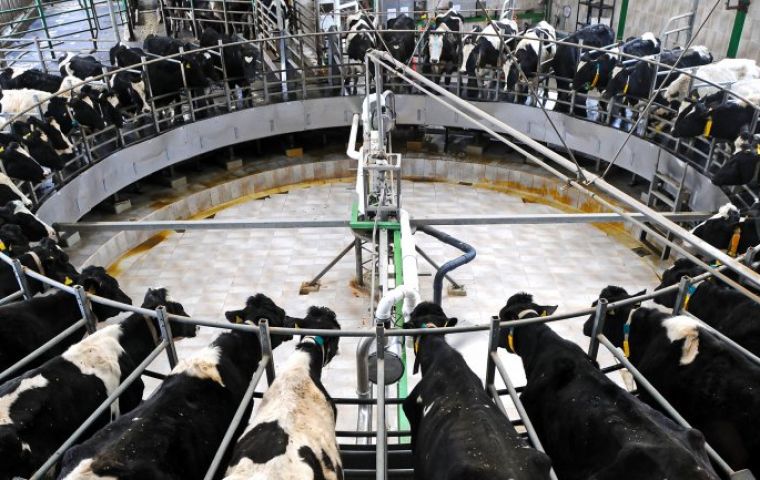MercoPress. South Atlantic News Agency
FAO Food Price Index in March: sugar up, dairy products down and meats stable
 While prices for all dairy commodities fell, butter and cheese were the most affected, reflecting a build-up of stocks in the major exporting countries.
While prices for all dairy commodities fell, butter and cheese were the most affected, reflecting a build-up of stocks in the major exporting countries.  Poultry and bovine meat prices remained essentially unaltered in March compared to the previous month, as global supply and demand remained well-balanced.
Poultry and bovine meat prices remained essentially unaltered in March compared to the previous month, as global supply and demand remained well-balanced.  Sugar prices climbed 17.1% from February reaching its highest level since November 2014, reflecting expectation of a large production deficit
Sugar prices climbed 17.1% from February reaching its highest level since November 2014, reflecting expectation of a large production deficit The FAO Food Price Index for March rose by 1.0% compared to February, as soaring sugar prices and continued increase in palm oil quotations more than offset plunging dairy product prices. The Index averaged 151.0 points in March, its highest level in 2016, but still some 12.0% below its level of a year earlier.
The FAO Food Price Index is a trade-weighted index tracking international market prices for five key commodity groups: major cereals, vegetable oils, dairy, meat and sugar. Its decline over the past year reflects ample food supplies, a slowing global economy and a stronger US dollar.
The keystone FAO Cereal Price Index fell slightly in March - marking the fifth straight month of decline- amid a favorable supply outlook in the new season. The drop was far more pronounced if compared to last year, as the sub-index is down 13.1% below its March 2015 level.
The main feature last month was the strong rebound in sugar prices, which, combined with a further increase in vegetable oil quotations, more than offset a plunge in dairy values.
The FAO Cereal Price Index averaged 147.6 points in March, down marginally from February, but 13.1% less than in March 2015. Wheat prices averaged slightly lower, as a result of strong competition and a generally favorable supply outlook in the new season. Maize quotations remained under downward pressure, largely influenced by favorable production prospects in South America, weak import demand and larger than anticipated outlook for plantings in the United States. Rice prices were stable.
The FAO Vegetable Oil Price Index rose to 159.8 in March, up 6.3% (9.5 points) from February, hitting a 15-month high. The upturn was driven by palm oil, the component of the index with the highest weight. International palm oil prices surged for the second consecutive month on concerns about stagnating global production in 2016, following prolonged dry weather in Malaysia and Indonesia. By contrast, the average March prices of other oils remained either unchanged (soy oil) or fell (sunflower and rapeseed oil).
The FAO Dairy Price Index averaged 130.3 points in March, down 11.7 points (8.2%) from February – plummeting to a level last seen in June 2009. While prices for all dairy commodities fell, butter and cheese were the most affected, reflecting a build-up of stocks in the major exporting countries. In the case of milk powders, the declines have been contained by continued sales of SMP to intervention stocks in the EU, so providing an indicative base price for international transactions.
The FAO Meat Price Index averaged 146.4 points in March, practically identical to its February revised value. Prices were stable across the board. The removal of excess supplies through the aid to private storage scheme at the beginning of the year has helped to keep pig-meat export prices steady in the EU and, by extension, in the international market overall. Sheep-meat prices also stabilized, reflecting the end of the seasonal peak in supplies from Oceania. Poultry and bovine meat prices remained essentially unaltered compared to the previous month, as international supply and demand remained well-balanced.
The FAO Sugar Price Index averaged nearly 219 points in March, up 32 points (17.1%) from February and reaching its highest level since November 2014. Last month’s sharp increase mainly reflects the expectation of an even larger production deficit during the current crop year than earlier anticipated, following the recent heavy rainfall in Brazil, the world’s largest sugar producer. Reports of higher use of raw sugar for the production of ethanol in Brazil also boosted prices.

![“Working directly with President [Donald] Trump and Congress, we accomplished what no one else could,” Patel stressed](/data/cache/noticias/108417/130x80/fbi.jpg)


Top Comments
Disclaimer & comment rulesCommenting for this story is now closed.
If you have a Facebook account, become a fan and comment on our Facebook Page!